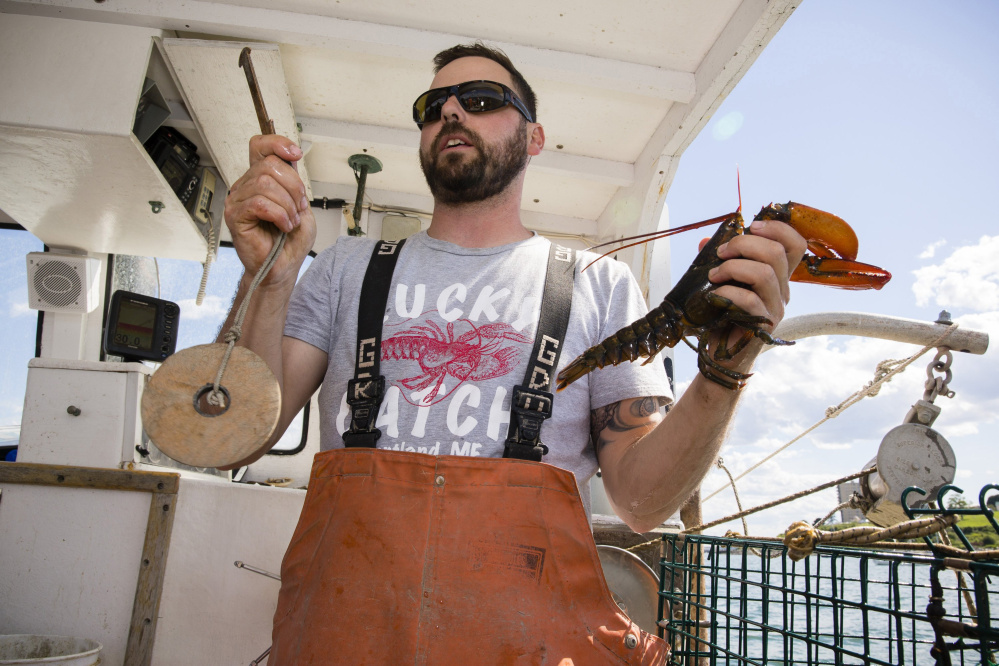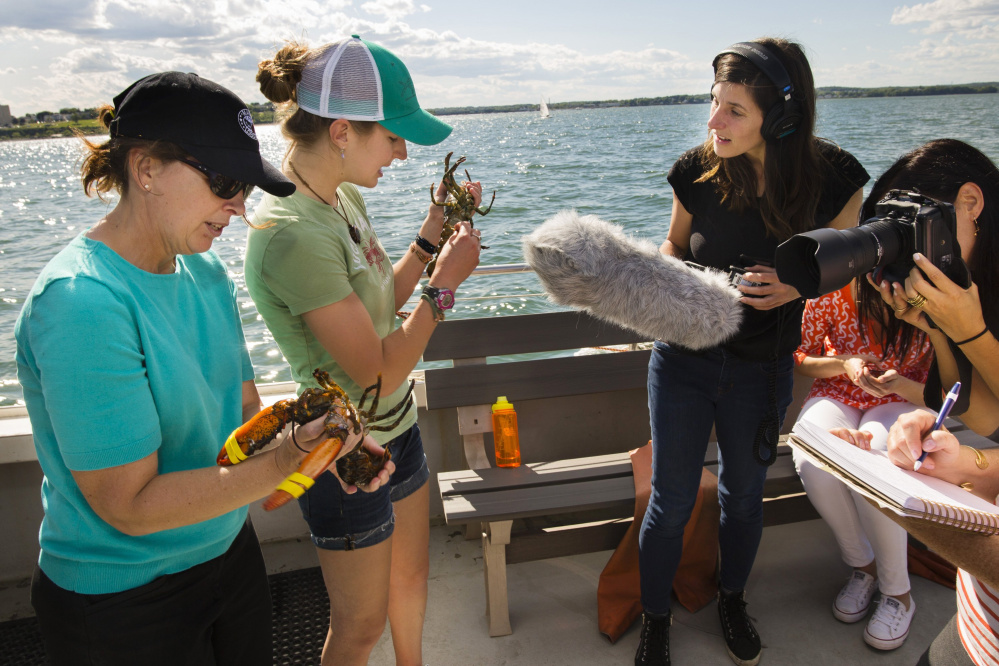Maine’s lobster marketing group is facing existential opposition from an unlikely source: the lobster industry.
With lobster prices down, both at the dock and the dealer’s office, some who make their living off the state’s signature crustacean are reluctant to approve another five years of funding to the Maine Lobster Marketing Collaborative, whose $2.2 million-a-year budget is funded by lobster license surcharges.
With its state funding about to expire, the collaborative is taking its case to fishermen in fire halls and ferry terminals from Kennebunk to Rockland this month, calling on powerful industry friends to lend their support and touting a new audit that gave the program stellar reviews. But it’s not an easy sell.
“I am not suggesting you haven’t accomplished a lot – I mean, wow, amazing! – but here’s the problem: it did not make me a penny, and it’s not gonna,” said Greg Griffin, a Cape Elizabeth lobsterman speaking at a recent zone council meeting. “My boat price has not been affected, period. Show me a guy here that is making more money because of what you do? No one. I don’t see my money returning me a penny. I am sorry.”
Low boat prices make it hard for some in the industry to swallow the license surcharge that funds the collaborative. The surcharge ranges from $165 a year for a lobsterman who fishes alone to $1,200 for a wholesaler or lobster transporter to $4,000 for the highest-volume processors. Some players in the industry hold more than one license, so they pay into the Lobster Promotion Fund that bankrolls the collaborative more than once.
The collaborative is cheered by some, including the Maine Lobstermen’s Association, and jeered by others, like Maine’s lobstering union. A recent post in the Facebook group “All Things Lobstering,” about whether the group should receive continued funding, generated hundreds of posts, both pro and con. At a spring legislative hearing, union members tried to defund the collaborative a year early. Others want the state to rejigger who pays how much, or fund part of the budget itself.
Supporters argue a state that relies so heavily on one product needs to make sure it is doing its best to sell that product. The cost of the license surcharge isn’t much more than what the average lobsterman spends on bait in a day, they argue. And state law created the collaborative to market lobster, not necessarily to raise the price, although growing demand undoubtedly must help.
“It certainly can’t hurt,” said Steven Taylor, a Kittery lobsterman who chairs the state’s southernmost lobster council. “You can’t have a near billion-dollar industry like we got in Maine and not have some kind of marketing. That’s just plain ludicrous. He’s trying. What we’re paying for it don’t amount to nothing. A couple carton of cigarettes. A night out at McDonald’s with the family. Who knows what the price would be like if they weren’t here.”
EVENTS BEYOND THEIR CONTROL
The Maine Lobster Marketing Collaborative is appealing to zone councils around the state to support legislation to extend its $2.2 million-a-year budget for another five years. To bolster his case, director Matt Jacobson is tapping a network of industry supporters to deliver testimonials, and touting a new third-party audit that gives the agency an outstanding review.
“The MLMC’s campaign has reinvigorated one of the oldest seafoods in America, giving it new relevancy to chefs, culinary professionals, media and diners,” said Don W. Stacks, the University of Miami professor who conducted the audit and the author of several books on corporate public relations. In his cover letter, Stacks wrote: “I have evaluated many public relations campaigns over the years. … Your campaign clearly stands out.”
But the six-page audit, which cost the agency about $10,000 to commission, doesn’t hold a lot of water in lobstering circles. It doesn’t evaluate how the marketing efforts have affected the price of lobsters, which is the only metric that really matters to some in this $533 million-a-year industry. Unfortunately for the collaborative, the price of lobster is down right now, even though catch has been slow and global demand remains strong.
Jacobson blames the low boat prices on things that no promotional council can control, like hurricanes that ruined the summer restaurant seasons in lobster-loving cities like Miami and Houston, and a trade deal between Canada and the European Union that put Maine lobsters at a huge competitive disadvantage with a customer that had traditionally bought 20 million pounds of lobster a year. Tough presidential trade talk on South Korea, another big lobster importer, hurt the Maine market, too.
“There’s a lot that we can’t impact,” Jacobson said. “Europe, Korea, that represents a huge market. Just think about it. Your market tanked in 2012 after 6 million pounds of lobster came in early. Imagine what losing a 20 million-pound customer does to it. And Korea, buyers are switching over, too, to get their supply chain in place. All this happens and then boom, two of our big domestic cities get hit by the hurricanes and you lose those markets just as our catch is coming in.”
‘THE CHEFS EAT IT UP’
During his presentation, Jacobson explains the strategy behind the agency’s decision to focus its time and attention on winning over American chefs. Persuade the rock star chef to put Maine’s signature new-shell lobster – that’s the collaborative’s new term for soft-shell or shedders – on his menu and the food media and other chefs notice, building demand for this uniquely Maine product during the summer, when the catch is usually high and the price is usually low. Jacobson takes lobstermen with him to visit food cities around the country, letting the harvesters tell the colorful, eco-friendly story of Maine’s most important fishery.
“The chefs eat it up,” Jacobson said. “I’ve never had one who didn’t put Maine new shell on their menu after talking with one of our guys. It works every single time.”
Jacobson said he would like to do more. He would love to market Maine lobster to Europe and Asia. He would love to have multiple marketing campaigns playing out at one time. But the lobster collaborative’s yearly $2.2 million budget pales in comparison to the money spent to market other American food products, like pork, milk, beef or even California avocados, Jacobson said. The lobster collaborative can only afford to run one campaign at a time, he said.
MARKET FLUCTUATIONS
The lobstermen who fish in the state’s easternmost waters have long complained that the collaborative’s focus on boosting domestic demand for new-shell lobsters over the summer does not help raise their boat prices because their new-shell season starts months later than other parts of the state. But lobstermen who fish off the border with New Hampshire are now complaining the collaborative’s strategy isn’t lifting their prices, either.
Wholesaler Canaan Letourneau, the owner of Maine Lobster Outlet in York, said the collaborative has yet to prove its marketing is paying off. He said that it takes credit for helping the industry emerge from its 2012 slump – when a glut of spring lobsters sent prices into a nosedive – when it was really Maine dealers that revived the price by opening up the Asian market. The collaborative has never marketed Maine lobsters to Asia, he said.
He said high-quality Maine lobsters practically sell themselves in the summer tourist season. The collaborative needs to find a way to market and sell lobsters with shells that are too soft to ship anywhere, Letourneau said. The Canadian processors are the only ones who will buy these super-soft lobsters, which Letourneau says make up about 30 percent of what he buys from harvesters. That drives prices down for all lobster, not just the super softs, he said.
“Selling lobsters is not a problem. I can do that. I’m good at that,” Letourneau said. “We can’t sell the ones that aren’t fit for market. We need to create a demand for that.”
The collaborative has about six months to make its case. It will wrap up its tour of lobster zone councils this month. Each council will vote on whether to continue support for the collaborative’s work. Both councils that have considered the issue so far – Zones D and G – have voted in favor of continued funding. Council liaisons will share the results with the Lobster Advisory Council on Dec. 14, which will make a recommendation to the Maine Legislature’s Marine Resources Committee.
It will be up to that committee to decide whether to introduce new legislation to continue the group’s charge. Without it, the collaborative will cease to exist in October 2018.
Send questions/comments to the editors.






Success. Please wait for the page to reload. If the page does not reload within 5 seconds, please refresh the page.
Enter your email and password to access comments.
Hi, to comment on stories you must . This profile is in addition to your subscription and website login.
Already have a commenting profile? .
Invalid username/password.
Please check your email to confirm and complete your registration.
Only subscribers are eligible to post comments. Please subscribe or login first for digital access. Here’s why.
Use the form below to reset your password. When you've submitted your account email, we will send an email with a reset code.